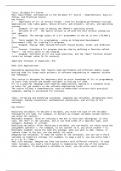Class notes
C++ (or “C-plus-plus”) is a generic programming language for building software. It's an object-oriented language. In other words, it emphasizes using data fields with unique attributes (a.k.a. objects) rather than logic or functions.
- Course
- Institution
C++ is an object-oriented programming (OOP) language that is viewed by many as the best language for creating large-scale applications. C++ is a superset of the C language. A related programming language, Java, is based on C++ but optimized for the distribution of program objects in a network such ...
[Show more]



